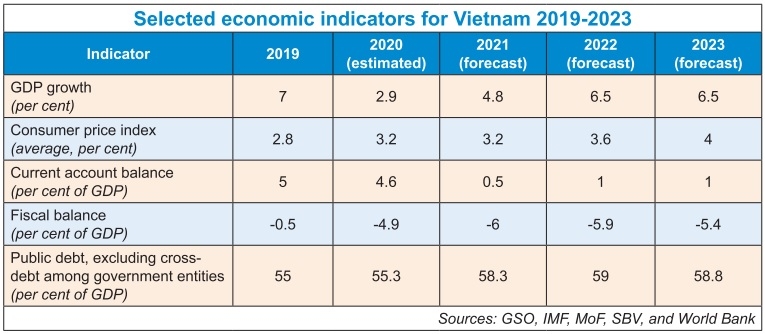A digital slant for economic recovery
 |
| The government’s national digital strategy acknowledges how vital it is for Vietnam to go digital in all areas. Photo: Shutterstock |
Having performed remarkably well in 2020 both in controlling the spread of COVID-19 and achieving one of the highest GDP growth rates in the world, at 2.91 per cent, Vietnam’s economy grew by a solid 5.64 per cent in the first quarter of 2021.
However, today Vietnam is facing its most severe COVID-19 outbreak since the beginning of the pandemic, partly due to low vaccinations. Since early May, manufacturing and services activities have been increasingly hamstrung by targeted lockdowns to contain community transmission of the virus. Especially since mid-July, mobility restrictions have been widened, with the southern region, Ho Chi Minh City, and then Hanoi, placed under strict quarantine, affecting economic activities.
In the meantime, the economy also faces the risk of increased competition in its external markets as competitors who are ahead in vaccinations are restarting their production and could recapture some of the market shares they lost to Vietnam due to COVID-19-related production disruptions in 2020.
Therefore, the World Bank has warned, the economy “could be at risk of losing both its domestic and external drivers of growth” if the current outbreak is not rapidly contained.
 |
Lower forecast with risks
The World Bank last week released its fresh projection on Vietnam’s economic outlook, which is not as optimistic as the government expected.
“The Vietnamese economy could expand by around 4.8 per cent in 2021 and converge toward the pre-pandemic GDP growth rate of 6.5 to 7 per cent from 2022 onward,” said the bank’s August 2021 edition of the Taking Stock report, which analyses the grave impact the pandemic is having on the economy and its prospects.
“This projection remains positive but it is 2 percentage points lower than the one in December’s 2020 Taking Stock edition because of the negative effects associated with the latest COVID-19 outbreak and is subject to further risks to the downside. It is also lower than the government’s official projection of a GDP growth rate of 6 per cent in 2021,” said the report.
This new projection assumes that the current outbreak will gradually be brought under control, allowing the economy to rebound in the fourth quarter. This rebound will also be supported by the acceleration of the vaccination programme, which should cover at least 70 per cent of the adult population by mid-2022, preventing severe outbreaks.
“This projection should be made with caution as serious uncertainties remain around the magnitude and duration of the pandemic, including the rise of new variants and the pace of vaccination in Vietnam and in the rest of the world,” said Dorsati Madani, senior economic expert from the World Bank in Vietnam. “If these risks materialise, Vietnam’s economic recovery will be delayed, and the GDP growth rate in 2021 will be lower than the projected 4.8 per cent.”
Vietnam’s short- to medium-term economic prospects will depend on several factors such as the pace of national vaccinations; the evolution of the coronavirus pandemic, and thus resumption of economic activities in countries that compete with Vietnam in export markets; and weaker-than-expected growth especially in Vietnam’s key export markets could weigh on the recovery. Currently, the recovery in the US, the European Union, and China is underway but remains fragile.
“If one or more of these risks were to materialise, exports and domestic demand would not rebound as expected. The economy could in a low case scenario still grow by 3.2 per cent in 2021 and 5.5 per cent in 2022,” the World Bank report stated.
However, global analysts FocusEconomics last week also predicted that Vietnam’s GDP is projected to grow at one of the fastest paces in the region this year, with domestic activity rebounding on a strong manufacturing sector and improving foreign demand boosting exports. “However, the recent surge in daily COVID-19 cases represents a key downside risk to the outlook. Our panelists expect GDP to expand 5.8 per cent in 2021, which is down 0.6 percentage points from last month’s forecast, and 6.8 per cent in 2022.”
Seeking a way out
According to experts, the most effective immediate solutions now to protect people’s lives and spur on economic activities will be boosting vaccination programmes.
However, in the long term, there may be new variants of the pandemic which can continue causing disruptions in traveling, production, and business activities. Thus Vietnam needs to develop a contactless economy with the application of digital technologies. This will enable the nation to escalate in the regional and global value chains.
“If one believes in the predictive power of financial markets, digitalisation will be the future of the Vietnamese economy,” said Jacques Morisset, the World Bank lead economist and Programme Leader for Vietnam.
Over the past year, the value of several local high-tech companies has surged by around 200 per cent on the Ho Chi Minh City Stock Exchange, including Digiworld, a market expansion provider, and Vien Lien, a telecommunications equipment business, which were up by 252 per cent and 189 per cent, respectively.
“As the world tries to emerge from the COVID-19 crisis, it has become clear that digital transformation will have an increasingly important role in the global economy,” Morisset said. “Countries are already competing globally for digital supremacy, and the Vietnamese government has clearly indicated it wants to be in the race by making digital transformation one of the central objectives of its 2021–2030 National Development Strategy.”
According to Hoang Anh Tu, vice head of the Ministry of Information and Communications’ Department of International Cooperation, the government has issued the National Digital Transformation Programme with the three key pillars of digital government, digital economy, and digital society. Vietnam’s goal by 2025 is that the digital economy will create 20 per cent of GDP, while there will be 100,000 digital technology enterprises, and Vietnam will be the best place in the region for digital businesses to do business and succeed, and the country will become a digital nation.
“We are living in an uncertain world and we all want to find certainty in uncertainty,” Tu said. “I think two things are bound to happen. One is digital transformation and digital technology will continue developing, and another is Vietnam will overcome COVID-19 and soon return to the new normal.”
Currently, Vietnam is one of the fastest-growing internet economies in the region, although arguably from a low base, according to the World Bank. Concretely, e-commerce sales have been growing at a similar pace as world e-commerce sales and faster than GDP. In 2020, Vietnam’s e-commerce market value reached almost $12 billion or 2.5 per cent of GDP.
It is estimated that 53 per cent of the population has shopped online using social networking platforms, such as Facebook and Zalo, or e-commerce platforms like Lazada, Shopee, and Tiki.
According to an e-commerce development plan approved by the Vietnamese government, the sector’s revenues are targeted to reach $35 billion by 2025. To achieve that target, e-commerce sales will have to annually grow by roughly 16.2 per cent.
But Morisset said Vietnam is in a good but uneven position to become a digital powerhouse. “Vietnam is one of the most connected in the world, especially for its income level, with high mobile and internet penetration rates, and an increasing use of IT tools and platforms by businesses. It also hosts several of the world’s leading IT companies,” he said. “However, Vietnam is lagging in several dimensions such as skills, financing, and a conducive regulatory environment that include data access and security, that will prevent it from making the most of the rapid digital transformation.”
To become a digital powerhouse, he suggested, Vietnam will need to offer the conditions that will enable its local operators to adopt and adapt new global digital technologies.
“So far, the country has done a good job. Today, it compares well to peer and aspirational comparators in penetration of mobile phones and its citizens and enterprises are well connected to the internet,” Morisset said. “Its digital infrastructure is quite modern, covering all provinces, and funded by forward-looking national telecommunication companies. It also hosts several world-leading IT firms such as Apple, Samsung, and Intel. This demonstrates Vietnam’s competitiveness and offers a unique platform for local firms and developers - the model adopted by Japan and South Korea in the 1970s and 1980s, and more recently by China.”
What the stars mean:
★ Poor ★ ★ Promising ★★★ Good ★★★★ Very good ★★★★★ Exceptional
Related Contents
Latest News
More News
- PM orders investment model for North–South high-speed rail (December 22, 2025 | 17:43)
- First members of Danang International Finance Centre revealed (December 22, 2025 | 17:39)
- Securing capital and efficiency for Vietnam’s 2026-2030 growth ambitions (December 17, 2025 | 10:00)
- Driving double-digit growth through green and circular transformation in Vietnam (December 17, 2025 | 09:00)
- Vietnam bucking trend in the global M&A landscape (December 16, 2025 | 14:20)
- Vietnam’s green transition demands collective financial action (December 15, 2025 | 12:00)
- VIR workshop highlights capital and policy for sustainable development (December 15, 2025 | 11:00)
- National Assembly approves pilot mechanisms to accelerate major projects in Hanoi (December 12, 2025 | 11:29)
- Vietnam eases policy approval requirements, simplifies foreign and outbound investments (December 11, 2025 | 17:53)
- Unpacking new momentum in Vietnam’s M&A market (December 10, 2025 | 09:59)

 Tag:
Tag:




















 Mobile Version
Mobile Version